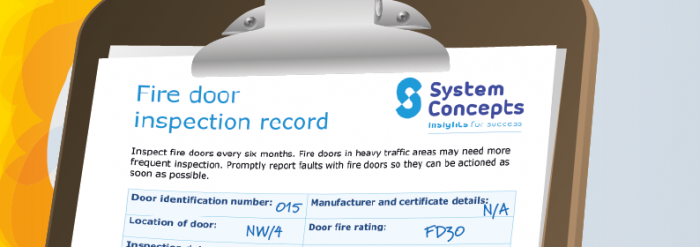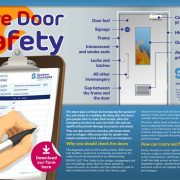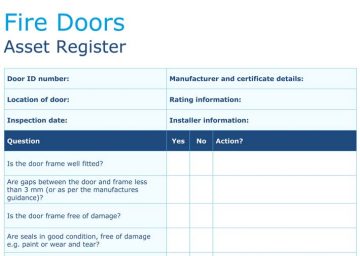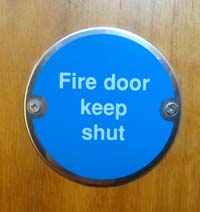Is your fire safety fit for purpose?
Discover how our specialists can help you meet your fire safety responsibilities...
Discover how our specialists can help you meet your fire safety responsibilities...

Fire door safety is an important part of every building’s fire strategy. We’ve put together a useful asset register, and an infographic, to help you ensure you’ve got it covered. See the free download links below, plus a quick overview of why fire door safety deserves priority attention.
Our helpful infographic and asset register can be downloaded (links below), and used to help you carry out general fire door checks. Following the recommendations provides assurance to your building occupants, as well as to others such as insurers, fire risk assessors and the local fire authority, that your fire doors are well managed and effective.
 Fire door safety advice
Fire door safety advice Fire door safety asset register
Fire door safety asset registerFire doors prevent the passage of fire and smoke through a building, allowing occupants vital time to reach a final exit safely. They also offer protection to occupants including the fire services who enter a building, the building structure itself, and its contents.
Building designs should include measures to restrict the spread of fire, protecting occupants and allowing for a suitable escape plan to be designed. Known as compartmentation, this includes the use of fire resisting materials to construct floors, ceilings and walls. Of course, buildings need to function and allow people and traffic to flow within them, e.g. between rooms, offices or floors, while maintaining the compartmentation. This is where fire doors come in.
Without proper fire door selection, siting, maintenance and checking, they could become ineffective and a weak link in your building’s fire strategy.
Make sure your fire doors are certified and labelled, to confirm they offer the intended level of protection in accordance with BS 476-22. Certification labelling is usually evidenced via coloured plugs in the door leaf or door frame, or by a label attached to the door displaying information including the manufacturers name, phone number, a door serial number and the door’s fire rating.
Unless there is a special fire risk in a building, fire doors are most commonly rated as ‘FD30’ and ‘FD60’– meaning they offer fire protection for 30 or 60 minutes respectively. If you’re responsible for fire safety in buildings, you should also check whether the insurers or other interested parties, such as the local fire authority, have specific requirements regarding fire doors.

Your fire doors should also be signed and marked as to whether they:
· Should be kept closed when not in use.
· Are to be kept locked when not in use.
· Are held open by an automatic release mechanism.
Fire doors should be routinely inspected to ensure they remain fit for purpose and provide the protection intended. BS 9999 recommends routine inspections are carried out daily, monthly, three monthly, six monthly and annually.
| Frequency | What to do |
| Daily | Automatic release mechanisms should be ‘test released’ |
| Monthly | Doors with hold open devices should be tested by simulating a power failure, a fire detector or fire alarm activation |
| Three monthly | As daily and monthly above |
| Six monthly | Check smoke seals are undamaged, there is no structural damage, and gaps in doors are not too small or too large to affect smoke sealing, opening and closing devices are operating correctly |
| Annually | As all the above |
In addition to the table above, carrying out and periodically reviewing a building fire risk assessment will help ensure fire hazards are identified and evaluated, to ensure control measures are suitable.
Make sure you add fire door safety checks to your preventive maintenance schedule. An asset register of fire doors throughout each building will help avoid any being missed.
Your fire door records should detail any faults found and action required, so they can be monitored through to completion. And when repairs to fire doors are required, they should be completed by a competent person (to ensure they know what to look for, and understand how fire doors function) who is certified to repair and maintain fire doors. Finally, the competent person should provide evidence to confirm that any remedial work has been carried out to the applicable standard(s).

Contact our consultants to access specialist knowledge and services
Discover how our specialists can help you meet your fire safety responsibilities...
Discover how our specialists can help you meet your fire safety responsibilities...
Our experienced consultants provide a wide range of health and safety risk assessments and audit services...
Our experienced consultants provide a wide range of health and safety risk assessments and audit services...
How we helped a client with the audibility of their fire alarm voice address system...
How we helped a client with the audibility of their fire alarm voice address system...